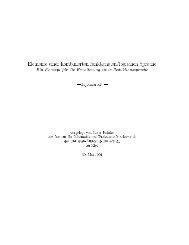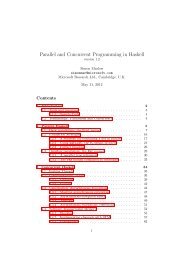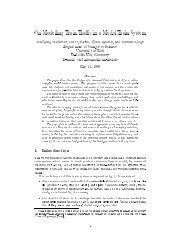GPU programming with Accelerate - Haskell Community Server
GPU programming with Accelerate - Haskell Community Server
GPU programming with Accelerate - Haskell Community Server
Create successful ePaper yourself
Turn your PDF publications into a flip-book with our unique Google optimized e-Paper software.
Parallel & Concurrent <strong>Haskell</strong> 7:<br />
GP<strong>GPU</strong> <strong>programming</strong> <strong>with</strong><br />
<strong>Accelerate</strong><br />
Simon Marlow
What is GP<strong>GPU</strong> <strong>programming</strong>?<br />
• General Purpose Graphics<br />
Processing Unit<br />
• i.e. using your graphics<br />
card to do something<br />
other than play games or<br />
zoom windows<br />
• <strong>GPU</strong>s have many more<br />
cores than your CPU:<br />
Device 0: GeForce GTX 580 (compute capatability 2.0)<br />
16 multiprocessors @ 1.54 GHz (512 cores), 1 GB global memory
• Main difference:<br />
– All the cores run the same code at the same time<br />
– (but operate on separate data)<br />
• SIMD (Single Instruction Multiple Data)<br />
– or just “Data Parallelism”<br />
• We can’t program a <strong>GPU</strong> in the same way as a<br />
CPU – it has a different instruction set, and we<br />
can’t run <strong>Haskell</strong> programs on it directly<br />
• The <strong>GPU</strong> has its own memory, so data has to<br />
be explicitly moved back and forth
<strong>Accelerate</strong><br />
• <strong>Accelerate</strong> is a Domain-specific language for<br />
<strong>GPU</strong> <strong>programming</strong><br />
Running<br />
<strong>Haskell</strong>/<strong>Accelerate</strong><br />
program<br />
CUDA code<br />
Compiled by NVidia’s compiler,<br />
loaded onto the <strong>GPU</strong>,<br />
and executed.<br />
Results of the <strong>GPU</strong> computation<br />
• This process may happen several times during the program’s execution<br />
• The CUDA code isn’t compiled every time – code fragments are cached and re-used
• So when you program using <strong>Accelerate</strong>, you<br />
are writing a <strong>Haskell</strong> program that generates<br />
a CUDA program<br />
• But in many respects, it looks just like a<br />
<strong>Haskell</strong> program. (It shares various concepts<br />
<strong>with</strong> Repa too)<br />
• For testing, there is also an interpreter that<br />
can run the <strong>Accelerate</strong> program <strong>with</strong>out using<br />
the <strong>GPU</strong><br />
– much more slowly of course
Some practical details<br />
$ cabal install accelerate<br />
$ cabal install accelerate-cuda<br />
$ ghci<br />
Prelude> import Data.Array.<strong>Accelerate</strong> as A<br />
Prelude A> import Data.Array.<strong>Accelerate</strong>.Interpreter as I<br />
Prelude A I><br />
• Hopefully by the time you read this the <strong>Accelerate</strong> devs<br />
will have fixed the bugs that I found while writing this<br />
lecture <br />
• Now we’re ready to play <strong>with</strong> some of the basics.<br />
• <strong>Accelerate</strong> is a large API, have the docs to hand:<br />
http://hackage.haskell.org/packages/archive/accelerat<br />
e/0.12.0.0/doc/html/Data-Array-<strong>Accelerate</strong>.html
Arrays and indices<br />
• <strong>Accelerate</strong> computations take place over arrays<br />
Input<br />
arrays<br />
<strong>Accelerate</strong><br />
computation<br />
Output<br />
arrays<br />
• The Array type has two type parameters:<br />
The shape of the<br />
array (think:<br />
dimensions)<br />
data Array sh e<br />
The element type of the array<br />
A fixed set of element types are<br />
supported: Int8, Int32, Float, etc.,<br />
and tuples.
• Shapes:<br />
data Z = Z<br />
data tail :. head = tail :. head<br />
• Z stands for zero dimensions (a scalar, <strong>with</strong> one<br />
element)<br />
• Z :. Int is the shape of a one-dimensional array (a<br />
vector) indexed by Int<br />
• In fact, the only index type allowed is Int<br />
• Z :. Int :. Int is the shape of a two-dimensional array (a<br />
matrix) indexed by Int<br />
• (:.) associates left, so Z :. Int :. Int is (Z :. Int) :. Int<br />
• hence the tail/head naming in the type<br />
• types and values look similar:<br />
Z :. 3 :: Z :. Int
• Handy type synonyms:<br />
type DIM0 = Z<br />
type DIM1 = DIM0 :. Int<br />
type DIM2 = DIM1 :. Int<br />
type Scalar e = Array DIM0 e<br />
type Vector e = Array DIM1 e
Playing <strong>with</strong> <strong>Accelerate</strong> arrays<br />
• <strong>Accelerate</strong> provides some operations for<br />
experimenting <strong>with</strong> arrays, <strong>with</strong>out using the<br />
<strong>Accelerate</strong> DSL itself.<br />
fromList :: (Shape sh, Elt e) => sh -> [e] -> Array sh e<br />
ghci> fromList (Z:.10) [1..10]
Playing <strong>with</strong> <strong>Accelerate</strong> arrays<br />
• <strong>Accelerate</strong> provides some operations for<br />
experimenting <strong>with</strong> arrays, <strong>with</strong>out using the<br />
<strong>Accelerate</strong> DSL itself.<br />
fromList :: (Shape sh, Elt e) => sh -> [e] -> Array sh e<br />
ghci> fromList (Z:.10) [1..10]<br />
:9:1:<br />
No instance for (Shape (Z :. head0))<br />
arising from a use of `fromList'<br />
Possible fix: add an instance declaration for (Shape (Z :. head0))<br />
In the expression: fromList (Z :. 10) [1 .. 10]<br />
In an equation for `it': it = fromList (Z :. 10) [1 .. 10]<br />
• Defaulting does not apply, because Shape is not a<br />
standard class
• Try <strong>with</strong> a type signature<br />
ghci> fromList (Z:.10) [1..10] :: Vector Int<br />
Array (Z :. 10) [1,2,3,4,5,6,7,8,9,10]<br />
• Ok, we made a vector from a list. Let’s try a matrix:<br />
ghci> fromList (Z:.3:.5) [1..] :: Array DIM2 Int<br />
Array (Z :. 3 :. 5) [1,2,3,4,5,6,7,8,9,10,11,12,13,14,15]<br />
1 2 3 4 5<br />
6 7 8 9 10<br />
11 12 13 14 15<br />
• fills along the rightmost dimension first.<br />
• Of course, the array is really just a vector internally<br />
• the shape (Z :. 3 :. 5) tells <strong>Accelerate</strong> how to<br />
interpret indices.
ghci> fromList (Z:.3:.5) [1..] :: Array DIM2 Int<br />
Array (Z :. 3 :. 5) [1,2,3,4,5,6,7,8,9,10,11,12,13,14,15]<br />
1 2 3 4 5<br />
6 7 8 9 10<br />
11 12 13 14 15<br />
• Of course, the array is really just a vector internally<br />
• the shape (Z :. 3 :. 5) tells <strong>Accelerate</strong> how to<br />
interpret indices.<br />
> let arr = fromList (Z:.3:.5) [1..] :: Array DIM2 Int<br />
> indexArray arr (Z:.2:.1)<br />
12<br />
1 2 3 4 5<br />
6 7 8 9 10<br />
11 12 13 14 15<br />
indices count from<br />
zero!
• You can even change the shape of an array <strong>with</strong>out<br />
changing its representation – e.g. change a 3x5<br />
array into a 5x3 array<br />
• but the operation is part of the full accelerate<br />
DSL, so we can’t demonstrate it yet
• Arrays of tuples<br />
> fromList (Z:.2:.3) (Prelude.zip [1..] ['a'..]) :: Array DIM2 (Int,Char)<br />
Array (Z :. 2 :. 3) [(1,'a'),(2,'b'),(3,'c'),(4,'d'),(5,'e'),(6,'f')]<br />
• Again this is really just a trick: <strong>Accelerate</strong> is turning<br />
the array of tuples into a tuple of arrays internally<br />
( , )<br />
1 2 3<br />
4 5 6<br />
a b c<br />
d e f<br />
• Note: there are no nested arrays. Array is not an<br />
allowable element type. Regular arrays only!
• Now to really run an <strong>Accelerate</strong> computation<br />
run :: Arrays a => Acc a -> a<br />
• run comes from either<br />
• Data.Array.<strong>Accelerate</strong>.Interpreter<br />
• Data.Array.<strong>Accelerate</strong>.CUDA<br />
• we’ll use the interpreter for now.<br />
• Arrays constrains the result to be an array, or a<br />
tuple of arrays<br />
• What is Acc?<br />
• This is the DSL type. Acc is really a data<br />
structure representing an array computation,<br />
that run will interpret (or compile and run on the<br />
<strong>GPU</strong>)
• First example: add 1 to every element<br />
> let arr = fromList (Z:.3:.5) [1..] :: Array DIM2 Int<br />
> run $ A.map (+1) (use arr)<br />
Array (Z :. 3 :. 5) [2,3,4,5,6,7,8,9,10,11,12,13,14,15,16]<br />
• We have to get our array into the Acc world:<br />
• this may involve copying it to the <strong>GPU</strong><br />
use :: Arrays arrays => arrays -> Acc arrays<br />
• Next, we use A.map to apply a function to every<br />
element<br />
• The A. disambiguates <strong>with</strong> Prelude.map<br />
A.map ::<br />
(Shape ix, Elt a, Elt b) =><br />
(Exp a -> Exp b) -> Acc (Array ix a) -> Acc (Array ix b)<br />
This is the function to apply<br />
to every element. But<br />
what’s Exp?
A.map ::<br />
(Shape ix, Elt a, Elt b) =><br />
(Exp a -> Exp b) -> Acc (Array ix a) -> Acc (Array ix b)<br />
• Acc a : an array computation delivering an a<br />
• a is typically an instance of class Arrays<br />
• Exp a : a scalar computation delivering an a<br />
• a is typically an instance of class Elt<br />
• In <strong>Accelerate</strong> the world is divided into Acc and Exp,<br />
so that we don’t accidentally use an array operation<br />
where an element operation is needed.<br />
• Overloading is used so that numeric <strong>Haskell</strong><br />
expressions can often be used where an Exp is<br />
required.<br />
• e.g. (+1) :: Exp Int -> Exp Int
• We can see the data structure that <strong>Accelerate</strong><br />
compiled our program to, by omitting the run:<br />
> A.map (+1) (use arr)<br />
map<br />
(\x0 -> x0 + 1)<br />
(use ((Array (Z :. 3 :. 5) [1,2,3,4,5,6,7,8,9,10,11,12,13,14,15])))<br />
• One more example:<br />
> run $ A.map (^2) (use arr)<br />
Array (Z :. 3 :. 5) [1,4,9,16,25,36,49,64,81,100,121,144,169,196,225]
Folds over arrays<br />
> let arr = fromList (Z:.10) [1..10] :: Vector Int<br />
> run $ fold (+) 0 (use arr)<br />
Array (Z) [55]<br />
• Folding (+) over the array gives the sum<br />
• The result was an array of one element (a scalar). Why?<br />
• fold has an interesting type:<br />
fold :: (Shape ix, Elt a)<br />
=> (Exp a -> Exp a -> Exp a)<br />
-> Exp a -> Acc (Array (ix :. Int) a) -> Acc (Array ix a)<br />
input array output array: outer<br />
dimension removed<br />
• The fold happens over the outer dimension of the array
let arr = fromList (Z:.3:.5) [1..] :: Array DIM2 Int<br />
> run $ A.fold (+) 0 (use arr)<br />
Array (Z :. 3) [15,40,65]<br />
1 2 3 4 5<br />
6 7 8 9 10<br />
11 12 13 14 15<br />
15<br />
40<br />
65
fold :: (Shape ix, Elt a)<br />
=> (Exp a -> Exp a -> Exp a)<br />
-> Exp a -> Acc (Array (ix :. Int) a) -> Acc (Array ix a)<br />
• Is it a left or a right fold?<br />
• Neither!<br />
• the fold happens in parallel, tree-like<br />
• therefore the function should be associative, otherwise<br />
the results will be non-deterministic<br />
• (we pretend that floating-point operations are<br />
associative, even though strictly speaking they aren’t)
Indexing an array<br />
(!) :: (Shape ix, Elt e) => Acc (Array ix e) -> Exp ix -> Exp e<br />
• To try this out we need to make a one-dimensional array<br />
from an Exp:<br />
unit :: Exp e -> Acc (Scalar e)<br />
• Try it:<br />
> let arr = fromList (Z:.3:.5) [1..] :: Array DIM2 Int<br />
> run $ unit (use arr ! (Z :. 2 :. 1))<br />
:19:24:<br />
Couldn't match expected type `Exp DIM2'<br />
<strong>with</strong> actual type `tail0 :. head0'<br />
In the second argument of `(!)', namely `(Z :. 2 :. 1)'<br />
In the first argument of `unit', namely `(use arr ! (Z :. 2 :. 1))'<br />
In the second argument of `($)', namely<br />
`unit (use arr ! (Z :. 2 :. 1))'<br />
• Ok, so we can’t just use (Z :. 2 :. 1) as an Exp ix
• Need a way to get from an (Z :. Int :. Int) to Exp (Z :. Int :. Int)<br />
index0 :: Exp Z<br />
index1 :: Exp Int -> Exp (Z :. Int)<br />
index2 :: Exp Int -> Exp Int -> Exp DIM2<br />
> let arr = fromList (Z:.3:.5) [1..] :: Array DIM2 Int<br />
> run $ unit (use arr ! index2 2 1)<br />
Array (Z) [12]
• Arrays can be reshaped:<br />
reshape :: (Shape ix, Shape ix', Elt e)<br />
=> Exp ix -> Acc (Array ix' e)<br />
-> Acc (Array ix e)<br />
> arr<br />
Array (Z :. 3 :. 5) [1,2,3,4,5,6,7,8,9,10,11,12,13,14,15]<br />
> run $ reshape (index2 5 3) (use arr)<br />
Array (Z :. 5 :. 3) [1,2,3,4,5,6,7,8,9,10,11,12,13,14,15]<br />
• It’s the same array data, just the shape is different<br />
• Indexing will show the difference:<br />
> run $ unit (use arr ! index2 2 1)<br />
Array (Z) [12]<br />
> run $ unit (reshape (index2 5 3) (use arr) ! index2 2 1)<br />
Array (Z) [8]<br />
1 2 3 4 5<br />
6 7 8 9 10<br />
11 12 13 14 15<br />
1 2 3<br />
4 5 6<br />
7 8 9<br />
10 11 12<br />
13 14 15
More Array operations<br />
zipWith :: (Shape ix, Elt a, Elt b, Elt c)<br />
=> (Exp a -> Exp b -> Exp c)<br />
-> Acc (Array ix a) -> Acc (Array ix b)<br />
-> Acc (Array ix c)<br />
> run $ A.zipWith (+) (use arr) (use arr)<br />
Array (Z :. 3 :. 5) [2,4,6,8,10,12,14,16,18,20,22,24,26,28,30]
Array creation<br />
• We don’t really want to create all our arrays in<br />
<strong>Haskell</strong> and then move them over <strong>with</strong> use<br />
– better to create them directly if possible<br />
fill :: (Shape sh, Elt e)<br />
=> Exp sh -> Exp e<br />
-> Acc (Array sh e)<br />
generate :: (Shape ix, Elt a)<br />
=> Exp ix -> (Exp ix -> Exp a)<br />
-> Acc (Array ix a)
Constants<br />
• Turn a <strong>Haskell</strong> value into an Exp:<br />
constant :: Elt t => t -> Exp t
Boolean operations<br />
• Standard boolean operations are available, but <strong>with</strong><br />
different names because the standard names are not<br />
overloaded in <strong>Haskell</strong>:<br />
(==*) :: (Elt t, IsScalar t) => Exp t -> Exp t -> Exp Bool<br />
-- also /=* =*<br />
(&&*) :: Exp Bool -> Exp Bool -> Exp Bool<br />
(||*) :: Exp Bool -> Exp Bool -> Exp Bool<br />
not :: Exp Bool -> Exp Bool<br />
• Conditionals (if):<br />
(?) :: Elt t => Exp Bool -> (Exp t, Exp t) -> Exp t<br />
> run $ A.map (\x -> x `mod` 2 ==* 1 ? (x * 2, x - 3)) (use arr)<br />
Array (Z :. 3 :. 5) [2,-1,6,1,10,3,14,5,18,7,22,9,26,11,30]<br />
• Use sparingly! Leads to SIMD divergence.
A Mandelbrot set generator
Basics<br />
• Operation over the complex plane<br />
• We pick a window onto the complex plane.<br />
– only points between -2.0 ... 2.0 on both axes are interesting<br />
– divide the window into pixels (e.g. 512x512), each pixel has a value c<br />
given by its coordinates on the plain<br />
• A point is in the set if when iterating this equation, the value of |Z|<br />
does not diverge:<br />
Z n+1 = c + Z n 2<br />
• where |Z| is given by sqrt(x 2 + y 2 )<br />
• definitely diverges if |Z| > 2<br />
– optimisation: drop the sqrt, check for > 4<br />
• Fixed number of iterations<br />
• Pretty pictures: colour depends on no. of iterations before<br />
divergence
• So the calculation for each pixel is independent: good for<br />
SIMD<br />
• Complications:<br />
• iteration<br />
• remember the iteration count when divergence occurs<br />
• there is likely to be some conditional somewhere,<br />
but we want to minimize this
Getting started<br />
• first some types:<br />
type F = Float<br />
type Complex = (F,F)<br />
type ComplexPlane = Array DIM2 Complex<br />
• Now let’s define the function we will iterate, next:<br />
next :: Exp Complex -> Exp Complex -> Exp Complex<br />
next c z = c `plus` (z `times` z)<br />
• Now we need to define plus and times<br />
plus :: Exp Complex -> Exp Complex -> Exp Complex<br />
plus a b = ...
• Exp Complex is Exp (Float,Float)<br />
• How can we deconstruct the pair inside the Exp?<br />
• <strong>Accelerate</strong> provides these:<br />
fst :: (Elt a, Elt b) => Exp (a, b) -> Exp a<br />
snd :: (Elt a, Elt b) => Exp (a, b) -> Exp b<br />
• So we can write:<br />
plus :: Exp Complex -> Exp Complex -> Exp Complex<br />
plus a b = ...<br />
where<br />
ax = A.fst a<br />
ay = A.snd a<br />
bx = A.fst b<br />
by = A.snd b<br />
• But we also need to construct the result pair<br />
• (ax+bx, ay+by) has type (Exp F, Exp F)<br />
• we want Exp (F,F)<br />
• Fortunately lift has this type (amongst many others)
• Fortunately lift has this type (amongst many others)<br />
lift :: (Exp F, Exp F) -> Exp (F, F)<br />
• So we have:<br />
plus :: Exp Complex -> Exp Complex -> Exp Complex<br />
plus a b = lift (ax+bx, ay+by)<br />
where<br />
ax = A.fst a<br />
ay = A.snd a<br />
bx = A.fst b<br />
by = A.snd b<br />
• In general, lift is for taking ordinary <strong>Haskell</strong> values into Exp<br />
or Acc, and unlift is for the opposite<br />
• (but it’s “more complicated than that”)<br />
• in fact, fst and snd are defined in terms of unlift:<br />
fst :: (Elt a, Elt b) => Exp (a, b) -> Exp a<br />
fst e = let (x, _:: Exp b) = unlift e in x
• So we can write plus in a slightly nicer way:<br />
plus :: Exp Complex -> Exp Complex -> Exp Complex<br />
plus a b = lift (ax+bx, ay+by)<br />
where<br />
(ax, ay) = unlift a :: (Exp F, Exp F)<br />
(bx, by) = unlift b :: (Exp F, Exp F)<br />
• Note we had to add some type signatures<br />
• rules of thumb for fixing type errors:<br />
• add type signatures<br />
• comment out code until it passes the type checker<br />
• There’s one more way to simplify this:<br />
• lift2 is a function that lifts the result and unlifts the<br />
arguments for a 2-ary function:<br />
plus :: Exp Complex -> Exp Complex -> Exp Complex<br />
plus = lift2 f<br />
where f :: (Exp F, Exp F) -> (Exp F, Exp F) -> (Exp F, Exp F)<br />
f (ax,ay) (bx,by) = (ax+bx,ay+by)<br />
• times is similar to plus.
What about iteration/conditionals?<br />
• Iteration is ok as long as we do the same thing to every<br />
element in every iteration<br />
• So we have to apply the function even to elements that<br />
have already diverged<br />
– (wasted work is not really an issue, we have lots of cores)<br />
• Key idea: keep a pair (z n,i) per element<br />
– z n is the current Z value<br />
– i is the iteration that divergence occurred, or the current<br />
iteration otherwise<br />
• So for each element, our inputs are (z,i) and c<br />
– compute z’ = next c z<br />
– if z’ diverged, result is (z, i)<br />
– else result is (z’, i+1)
iter :: Exp Complex -> Exp (F,F,Int) -> Exp (F,F,Int)<br />
iter c z =<br />
let<br />
(x,y,i) = unlift z :: (Exp F, Exp F, Exp Int)<br />
z' = next c (lift (x,y))<br />
in<br />
(dot z' >* 4.0) ?<br />
( z<br />
, lift (A.fst z', A.snd z', i+1)<br />
)<br />
• There are no nested tuples, so instead of (Complex, Int) we<br />
must use (F, F, Int)<br />
• First unlift z, and then call next<br />
• Next, check whether z’ has diverged<br />
• dot is just x 2 + y 2 (not shown)<br />
• If it has diverged, then return the old z<br />
• otherwise, return z’ and i+1<br />
• Due to SIMD divergence, the <strong>GPU</strong> will execute each<br />
iteration in two passes: first the true branches, then the<br />
false branches
Final pieces<br />
genPlane :: F -> F -- X bounds of the view<br />
-> F -> F -- Y bounds of the view<br />
-> Int -- X resolution in pixels<br />
-> Int -- Y resolution in pixels<br />
-> Acc ComplexPlane<br />
• calls generate to make the initial ComplexPlane<br />
mkinit :: Acc ComplexPlane -> Acc (Array DIM2 (F,F,Int))<br />
• makes the initial array of (z,i) values; the input to the first<br />
iteration
mandelbrot :: F -> F -> F -> F -> Int -> Int -> Int<br />
-> Acc (Array DIM2 (F,F,Int))<br />
mandelbrot x y x' y' screenX screenY depth<br />
= iterate go zs0 !! depth<br />
where<br />
cs = genPlane x y x' y' screenX screenY<br />
zs0 = mkinit cs<br />
go :: Acc (Array DIM2 (F,F,Int))<br />
-> Acc (Array DIM2 (F,F,Int))<br />
go = A.zipWith iter cs<br />
iterate :: (a -> a) -> a -> [a] -- in the Prelude<br />
• but... doesn’t that generate a program as large as the<br />
number of iterations?<br />
• <strong>Accelerate</strong> has some clever caching: it generates the<br />
code for one iteration and then re-uses it<br />
• You can see what it is generating <strong>with</strong> –ddump-cc
Finally<br />
• The main function calls run, and then feeds<br />
the output into Gloss to generate a picture<br />
• See the full code in code/mandel/mandel.hs<br />
• Run it like this:<br />
$ ghc –O mandel.hs<br />
$ ./mandel --size=512 --limit=256 --cuda
Wrap up<br />
$ cabal install accelerate accelerate-cuda<br />
• Hopefully 0.13 will be released by now (0.12<br />
had a couple of bugs that affect us)<br />
• Exercise: crack my password!<br />
• If you struggle <strong>with</strong> type errors, ask the<br />
assistants<br />
– add type signatures, comment-out code<br />
– figuring out conversions between types is the<br />
most common problem





